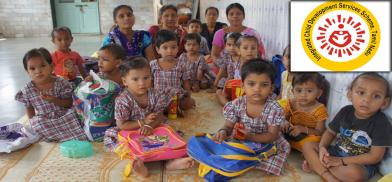ICDS can become a model for South Asia to improve lives of children
South Asian countries can use ICDS as a blueprint and further formulate their respective policies following a tailored and local approach depending on the domestic factors pertaining to their region, writes Vishwajeet Singh Raghav for South Asia Monitor

Started in 1975, the Integrated Child Development Services (ICDS) is a scheme launched by the Government of India for the welfare of women and children. ICDS, and under that Anganwadis (centres for performing the activities), have grown exponentially and have produced phenomenal results, becoming one of the world’s largest early-stage development schemes for vulnerable women and children in rural and urban-slum areas. There are more than 1.3 million operational centres which provide a host of activities for pregnant women, lactating women and children below six years.
Under the scheme, the focus is also given to preschool education, primary healthcare, health check-up and referral services to children under six years of age and their mothers are also the focus. After four and a half decades of its inception, ICDS is still going strong and has helped lakhs of people by delivering food and manufacturing masks even during the current lockdown.
Under the ICDS scheme, the Indian government is planning to distribute smartphones and tablets across India and have already covered many areas. Distribution of over 200,000 smartphones and tablets already have helped in real-time monitoring on the ground. The smartphones have the ICDS application pre-installed for data input and the Anganwadi centres are required to upload pictures of activities performed, children having food, scanning the barcode of ration packets, updating the nutritional level of children, etc. India is enlisted among the countries with the highest number of people suffering from malnutrition and the initiative has helped in identifying more than 12,000 malnourished children across six states.
Need for better infrastructure and motivated workers
Although, initiatives like these are important to boost the efficiency of these centres, and it has produced successful results, yet many problems related to basic infrastructure and functioning of these centres remain unresolved. Complaints regarding the dilapidated buildings, the broken furniture, and other poor amenities are regularly filed. Most importantly, the food, which is essential for one of the most fundamental aims of the scheme, i.e. to eradicate malnourishment, is often found to be of bad quality. The honorarium of the workers in these centres is extremely low and is even stalled for months sometimes, which forces them to borrow money. The bad conditions and low wages discourage and demotivate these workers. A hike in honorarium was declared by the Central government in 2018 but was not implemented to the promised level. There have been many protests demanding Employees’ Provident Fund (EPF), pension, minimum wages, etc. for the workers but these have not been delivered yet.
This, therefore, indicates that along with innovations like digitization of centres, there has to be an enhanced focus covering the basic aspects as well, otherwise, there is a likelihood of the scheme getting affected at the grassroots level, thereby reducing the momentum towards improvement and efficient service delivery. The functions undertaken by the scheme is crucial and it is imperative to keep the workers highly motivated, which can only happen if the government starts paying adequate attention towards their demands.
Though the top-down approach is practised and centralized plans are made by the government for the implementation of the programme, there is a dire necessity for some degree of customization while implementing the scheme. For instance, a centre located in an urban area would be different from that in a rural area and would also face entirely different issues. Going by personal observation, it was found that a lot of workers in centres across Sikar district in Rajasthan shared a common issue with respect to mobilization of children whose parents were both working. While on the other hand, centres in slum areas of Delhi face challenges such as the lack of a hygienic and a decent space for children due to high rental charges. Hence, the implementation of the scheme must also take local factors into consideration to increase the efficiency, reduce wastage and result in optimal utilization of resources.
Currently, the Anganwadis are grappling with many basic issues, yet at the same time, innovation is also necessary. Therefore, excessive focus on one aspect while neglecting the other would definitely hinder the progress of the scheme. Hence, digitization alongside guaranteeing basic necessities with a localized and customized approach can be an effective and efficient approach to move forward. In rural areas like Sikar, mobilization of children is a huge problem due to lack of transport for the Anganwadi workers, and providing cycles/scooters would definitely help them in this regard in villages which cover a large area and the ones where the houses are scattered. In urban areas like Delhi, providing an appropriate and hygienic place with adequate space and basic amenities would really help. There are numerous things that can be done, customization and innovation must be at the centre of the plan of action. The scheme holds a huge potential if an efficient approach is adopted.
ICDS is a brilliant scheme worth replicating
Even with all its shortcomings, the ICDS is a brilliant scheme which can work as a model for other South Asian countries, who grapple with somewhat similar issues. They can replicate the model with modifications suited for their respective regions. Pakistan has the highest infant mortality rate in South Asia and a significant cause for the same is maternal health during pregnancy. With a scheme like ICDS, the situation would definitely get better. Even the neonatal mortality rate is very high in South Asia as around a million new-born died in the eight South Asian countries in 2016, which is close to 40 percent of the total neonatal deaths in the world that year.
While countries like the Maldives and Sri Lanka are doing pretty well in these areas, other countries can definitely use India’s approach to fight the battle and make the situation better for the region. India still has to go long ways regarding both these issues as India ranks at the higher end of the charts. However, it has significantly slashed the number of deaths over the years.
Malnutrition is yet another challenge for South Asia. India, as discussed above, is also grappling with the problem but initiatives under ICDS have proved to be highly significant giving excellent results. Other nations of South Asia too can adopt similar measures to identify and treat people suffering from malnutrition.
Scope for fruitful intra-regional cooperation
ICDS has produced brilliant results and carries the potential of producing even better results. India needs to look into customization of its approach and also look for ways to have a cross-sectional impact which is not hindered by the disparity of the society responsible for various problems pertaining to children and women of the weaker section grappling with the problems and challenges mentioned above.
As for the rest of South Asia, similar schemes and programs can surely prove to be beneficial for countries facing these challenges. South Asian countries can use ICDS as a blueprint and further formulate their respective policies following a tailored and local approach depending on the domestic factors pertaining to their region. The countries can also consult India and can use the best practices. This can also become an opportunity for South Asian countries to improve their intra-regional cooperation.
Three of the top five countries with the highest youth population are in South Asia but if the situation is not dealt with appropriately then this demographic dividend can easily turn into a demographic disaster. As former US president John F. Kennedy rightly said, “Children are the world’s most valuable resource and its best hope for the future.” Hence, it is crucial for South Asian countries to get their act together and work towards improving the current situation in which ICDS can be a really useful tool.
(The writer is Masters in International Studies from the Symbiosis School of International Studies, Symbiosis University, Pune. He can be contacted at vishwajeetsingh76@gmail.com)










Post a Comment